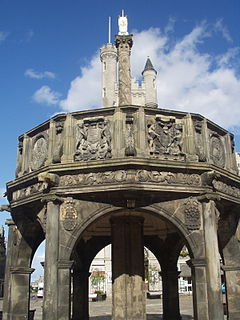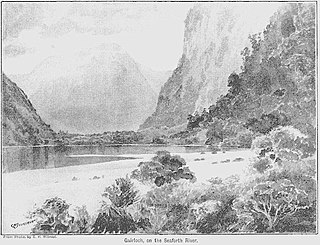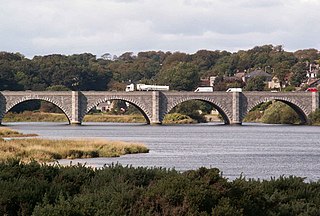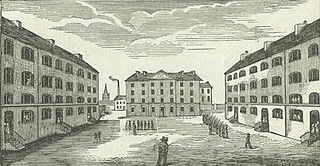
Marischal College is a large granite building on Broad Street in the centre of Aberdeen in north-east Scotland, and since 2011 has acted as the headquarters of Aberdeen City Council. However, the building was constructed for and is on long-term lease from the University of Aberdeen, which still uses parts of the building to house a museum and for ceremonial events. Today, it provides corporate office space and public access to council services, adjacent to the Town House, the city's historic seat of local government. Many Aberdonians consider Marischal College to be an icon of the "Granite City" and to symbolise the zenith of Aberdeen's granite-working industry.

Dornie is a small former fishing village in the Kintail district in western Ross-shire Highlands of Scotland. It is near the meeting point of Loch Duich, Loch Alsh and Loch Long.

Ochiltree is a village in East Ayrshire, Scotland, near Auchinleck and Cumnock. It is one of the oldest villages in East Ayrshire, with archaeological remains indicating Stone Age and Bronze Age settlers.
Aberdeen is one of the most prosperous cities in Scotland owing to the variety and importance of its chief industries. Traditionally Aberdeen was home to fishing, textile mills, ship building and paper making. There industries have all but gone now and have been replaced with high technology developments in the electronics design and development industry, research in agriculture and fishing and the oil industry which has been largely responsible for Aberdeen's economic boom in the last three decades.

Glasgow Cross is at the hub of the ancient royal burgh and now city of Glasgow, Scotland, close to its first crossing over the River Clyde. As a major junction in the city centre, its five streets run: north up the High Street to Glasgow Cathedral, Cathedral Square and the Royal Infirmary; east along Gallowgate and London Road, close to St Andrew's Square; south on the Saltmarket to Glasgow Green and the High Court; and its own Trongate continuing west as Argyle Street towards St Enoch Square and Buchanan Street.

Castlegate is a small area of Aberdeen, Scotland, located centrally at the east end of the city's main thoroughfare Union Street. Generally speaking, locals consider it to encompass the square at the end of Union Street where the Mercat Cross and Gallowgate are located.

Volodyovski (1898–1917) was a British Thoroughbred racehorse and sire. In a career which lasted from 1900 to 1902, he ran twenty-six times and won seven races. After being one of the leading two-year-olds of 1900, he went on to win The Derby in 1901. His subsequent form was disappointing and he was retired to stud after failing to win in eleven starts as a four-year-old. He made no impact as a stallion.

Arnisdale is a hamlet in the historic county of Inverness-shire in the local authority area of Highlands of Scotland. It lies on the north shore of Loch Hourn, around 10 miles down a single track road from Glenelg. It has a permanent population of around 30 and several holiday cottages. At the end of the village is a large white-painted hunting lodge called Arnisdale House, built by archtects Robert John Macbeth & Alexander Ross in 1898-1916. The house was built for Valentine Fleming of the banking family, who was killed in action in World War I, a year after the house was completed.

The Seaforth River is a river in New Zealand, flowing into Dusky Sound. About 9 km (5.6 mi) and 41 m (135 ft) up from Supper Cove in Dusky Sound is Lake Maree. The river rises about another 20 km (12 mi) to the north, on the slopes of the Black Giants, at about 1,300 m (4,300 ft). Like many former British Empire locations, it and its lakes have Scottish names.

The Bridge of Don is a five-arch bridge of granite crossing the River Don just above its mouth in Aberdeen, Scotland.

The Mayor of Invercargill is the head of the municipal government of Invercargill, New Zealand, and presides over the Invercargill City Council. The mayor is directly elected using a First Past the Post electoral system. The current mayor is Tim Shadbolt, who is also the longest-serving mayor for Invercargill. There have been 43 mayors so far.

Gallowgate Barracks were built in 1795. They were located at the east end of the Gallowgate, Glasgow, Scotland, and occupied in the year they were built.

Dunfermline College of Physical Education, was a college for training teachers of physical education and hygiene in Scotland. The college was established in Dunfermline in 1905, moved to Aberdeen in 1950, and merged with Moray House College of Education, University of Edinburgh, in 1987.

Huntly Railway Station was on the North Island Main Trunk line and the Awaroa Branch in the town of Huntly in the Waikato District of New Zealand, 65 mi (105 km) south of Auckland. It was 7.31 km (4.54 mi) north of Taupiri and 2.78 km (1.73 mi) south of Kimihia.

Ngāruawāhia railway station was at the junction of the North Island Main Trunk line and its Glen Massey branch, serving Ngāruawāhia in the Waikato District of New Zealand, 74 mi (119 km) south of Auckland and 10 mi (16 km) north of Hamilton. It was opened with a special train from Auckland on Monday 13 August 1877. The next stations were Taupiri 6.5 km (4.0 mi) to the north and Horotiu 5.5 km (3.4 mi) to the south.

Gallowgate is a neighbourhood of the city of Glasgow, Scotland. It takes its name from the major thoroughfare through the territory, which is part of the A89 road. Administratively, it is part of the Calton ward of the Glasgow City Council area.

The Triple Kirks in Aberdeen, Scotland were built at the time of the Disruption of 1843 when the Free Church of Scotland split from the Church of Scotland. The three churches were all part of a single building with a tall spire but they housed separate congregations. The East Free Kirk was completed 1843 followed by the West Free Kirk and South Free Kirk early the following year. From about 1966 the building progressively fell into disuse and became mostly ruinous but with the spire remaining.

Robert Gordon Wilson (1844–1931)) was a 19th/20th century Scottish architect based in Aberdeen. He was from a strong United Presbyterian background and specialised in churches for the United Presbyterian Church and Free Church of Scotland.

















